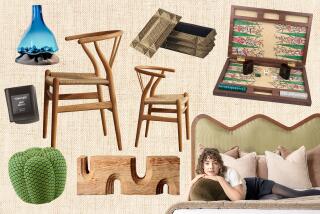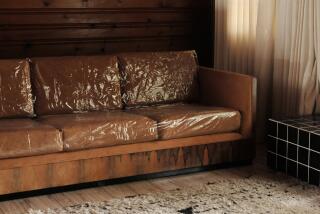Furnitureâs New Roles: Love Seats Arenât Just for Lovers Anymore
Love seat, vanity, hope chest, jelly cupboard--all useful pieces from the past that leave us with a fuzzy feeling of nostalgia.
But like todayâs TV stand, bookcase and computer desk, they are nothing more than furniture named for the roles they played.
Many remain in the retailerâs arsenal. Others, such as the recamier, metamorphic chair and tete-a-tete, are more elusive.
Clearly, the love seat is the most popular of the early pieces named for origin or function. As the name implies, it was once used by courting couples.
The love seatâs intended use went the way of the chaperon. But it is popular with decorators today, according to Ethan Allen Inc. of Danbury, Conn., because it adapts to a variety of spaces.
A pair of love seats often replaces a larger sofa in the living room. One alone can be the ideal size for extra seating in a family kitchen or master bedroom.
The wing chair is another upholstered piece that is aptly named. Wing-like panels on the chair back protected against cross-drafts and trapped warmth from the fireplace. All of that is no longer necessary, but the image remains one of coziness.
Likewise, jelly cupboards and pie safes once stored what the housewife cooked. And generations of young women lovingly put their handmade quilts and handworked linens into a cedar-lined hope chest for the day someone would ask for their hand.
Today, the notion of waiting to be âmarried offâ is quaint, and few have time to tat. So the Lane Co., which makes 150 styles in 90 finishes, refers to the storage unit as a cedar chest.
âBut 43% of our customers still refer to them as hope chests,â says Sean Slack, division vice president. âThe figure jumps to 55% when the customer is between the ages of 14 and 24.â
That, he says, is mainly because as young romantics theyâre interested in tradition.
Among other aptly named pieces still found in the home are the ottoman, from the Ottoman Empire, an early name for Turkey; the vanity; and the campaign chest.
*
The 19th century vanity, or dressing table, was a convenient place for a woman to âdress her hairâ and otherwise groom herself. It still is, if the bathroom is otherwise occupied. The vanity usually has a matching mirror and a lid that lifts to expose space for cosmetics and toiletries.
Some of the most glamorous vanities are mirrored Art Deco styles dating from the 1920s and â30s. If the provenance includes a famous name, the resale price goes up, according to Bruce Newman, author of âFantasy Furnitureâ (Rizzoli, 1989) and president of Newel Art Galleries of New York.
Campaign chests date from Napoleonic times. Antiques typically are two nesting two-drawer chests with brass handles at either side of each unit. They were used by military officers and carried into the battle area by enlisted men. Similarly, there was a folding campaign chair, usually a leather sling chair that folded flat.
The metamorphic chair, a staple in 19th century England, is seldom seen today. It was useful in the gentlemanâs library as a reading chair that converted to a stepladder to reach books on the upper shelves.
The S-shaped tete-a-tete chair has two seats with backs in opposite directions. The literal translation from French is âhead-to-head.â The chair seats two people side by side, facing each other, to facilitate intimate conversations.
Tete-a-tete chairs are hard to work into a decorating scheme, so they are rarely used today. But Newman says their flamboyance, either in the carving or upholstery, sometimes appeals to decorators.
One piece rarely made but still sought is the recamier, a one-arm chaise with a back that gracefully slopes from the arm to the foot. The recamier was named for a famous French beauty in the late 1700s.
âIt was a particularly graceful piece,â Newman says, âwhose purpose was primarily to make her look sexy.â


